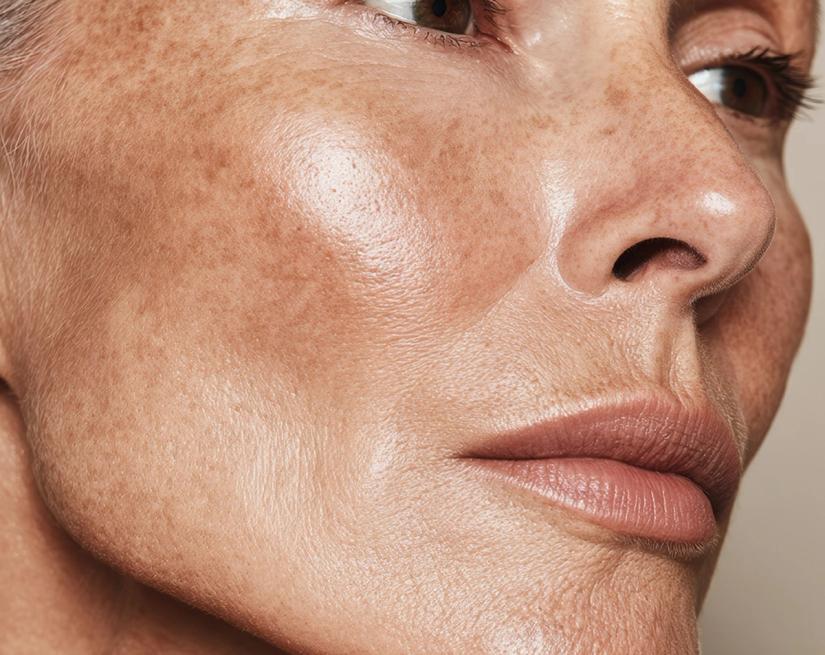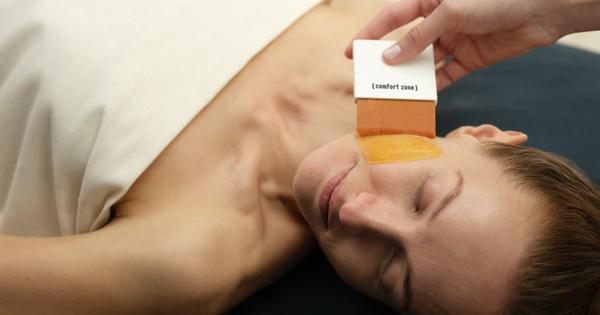SUBLIME SKIN MICROPEEL LOTION
Exfoliating lotion
skin care
Eve Mérinville | Corporate RD Excellence & SC RD and Innovation Director
10 min de lecture

Even though we try not to think about it, we all know our bodies are going to change as we get older. That flight of stairs is going to get a little more difficult to walk up. One day, we’re suddenly going to find small streaks of gray in our hair. And, unfortunately, our skin is going to show a little more wear and tear, whether from wrinkles, scars, or age spots.
You can’t completely prevent yourself from aging. But you can slow down (and in some cases, reverse!) the signs of aging with some simple lifestyle habits, like avoiding sun exposure and using effective skin care products.
Not only are age spots largely preventable, but even if you already have them, there are things you can do to fade their appearance.
"Age spots and liver spots have inflammation as an aggravating factor, that is why it is important to include an anti-inflammatory during the treatment course. Dermatologists often use a topical steroid for this purpose, which can be effective but can only be used for a short period of time. When incorporating home care products to reduce liver spots, look for gentle and plant-based ingredients with anti-inflammatory properties."
Christine Lee - Comfort Zone Master Educator
Age spots, also known as liver spots or sun spots, are patches of unusually dark skin on your body. They’re called age spots because they’re most likely to appear after age 50, although some people develop them earlier in life.
Age spots are caused by hyperpigmentation of your skin cells. This means that your skin starts producing too much pigment (color), making it appear darker than normal. The pigment that produces skin color is called melanin.
Why does your skin start overproducing melanin? It all comes down to your sun exposure. Ultraviolet (UV) rays from the sun speed up your body’s natural melanin production. Over time, UV rays can cause your skin to overproduce this dark pigment, leading to age spots.
Unlike freckles, which fade after sun exposure ends, age spots are more permanent. However, they do appear similar to freckles clumped together. They’re most common in areas of the skin that frequently receive sun exposure, like your face, arms, or hands as well as the tops of your feet.
Liver spots are not painful or itchy, but they do signify your body has received a significant amount of sun exposure. While age spots are not indicative of any serious medical condition, it’s a good idea to monitor them, as they can appear similar to some types of skin cancer.
Some people are more at risk of developing age spots, including people who:
If you fit into one of these categories but haven’t yet developed age spots, it’s a good idea to start protecting your skin now. Unlike freckles or a sunburn, age spots do not immediately appear when you’re overexposed to sunlight. Instead, sunlight exposure over time can cause them to develop as you age.
This means if you have years of too much sun exposure but start adequately protecting your skin today, you still might not be able to completely prevent age spots. However, you will likely reduce their prevalence and severity when they do develop.

Age spots aren’t inherently dangerous, but some people want them removed or faded for cosmetic reasons. Luckily, there are many treatment options available for age spots, although even after treatment it may take several months before you notice any results.
If you have questions about scheduling a treatment to fade age spots, contact a dermatologist. All of the treatments below can be performed as an outpatient in a dermatology office.
There are many skin lightening creams that might help fade your age spots. What we recommend is to look for boosters that contain retinol, retinal or 4-N-Butylresorcinol, and niacinamide.
These formulas will be at a different concentration than a prescription cream, but depending on the severity of your age spots, they could still be highly effective at reducing their appearance and preferable in order to avoid aggressions to the skin.
Also, steer away from any creams that contain mercury or ingredients such as calomel, cinnabaris, hydrargyri oxydum rubrum, or quicksilver. Mercury is extremely dangerous and should never be applied to the skin. It can cause severe liver and nervous system problems for you and for people around you.
Keep in mind that you may need to use an over-the-counter or prescription cream for several months before your age spots will visibly fade.
/skin regimen/Lx Retinol Serum visibly fades age spots in days by delicately removing affected skin from within. A 1.5% concentration of Encapsulated Retinol, Sylibin and Longevity ComplexTM stimulates the tissues regeneration and compactness, without triggering inflammatory mechanisms.
Chemical peels are effective at reducing the appearance of age spots because they essentially remove your uppermost skin layers. Since these layers are where the age spots are darkest, removing them makes your age spots appear lighter.
We recommend to receive your first chemical peels from expert Comfort Zone therapist, you can easily find on our spa locator, and you can use Comfort Zone and /Skin regimen/Lx over-the-counter products to exfoliate at home and intensify your results!
For a gentle over-the-counter treatment, combine Sublime Skin micropeel lotion with /skin regimen/Lx vitamin C booster to exfoliate off age spots and brighten dull skin.
Chemical peels performed by your dermatologist are more intense, so they can cause your skin to be red for several weeks. Because of this, many people prefer to have spa treatments and cosmetic solutions. In this case, we are here to help!
Both dermabrasion and microdermabrasion are processes that deeply exfoliate your skin. If you can picture a piece of sandpaper smoothing out a cut of wood, then you have some idea of what dermabrasion is like.
With dermabrasion, your skin is exfoliated using a brush. The upper layer of skin, which contains the darkest age spots, is sanded down. Over time, new skin that’s less dark in color grows to replace it. In the interim, your skin may be red and swollen.
Microdermabrasion is a similar, but less intense, process. Instead of a brush, small crystals are used to exfoliate your skin. As a result, the adverse effects of redness and swelling are less noticeable, but the results are less noticeable, too.
Laser resurfacing is an intriguing option for many people wanting to reduce the appearance of age spots because, unlike cryotherapy, dermabrasion, or chemical peels, it doesn’t damage the surface of your skin.
Laser resurfacing involves a dermatologist shining a laser on your age spots. This laser destroys the cells responsible for your hyperpigmentation. Laser resurfacing does require multiple treatments, and it might temporarily cause scabbing in the area of your age spots.
If you’re not experiencing age spots yet, congratulations! A lifelong habit of mindful skin protection is essential to ensuring you don’t develop age spots in the future. The best thing to do to prevent age spots is apply sunscreen to all areas of your body regularly exposed to the sun.
Many people recognize the importance of daily sunscreen use as part of their facial skin care routine, which has the added benefit of helping to prevent facial wrinkles and dryness. However, since age spots can develop on any skin exposed to excessive sunlight, applying sunscreen all over your body is recommended.
In addition, limiting sun exposure during peak intensity hours (10 a.m. to 2 p.m.) can help reduce your risk of developing age spots. If you must go out into the sun, apply sunscreen and wear a sun hat to protect your face and neck from sun exposure.
Even if you are already seeing some of the signs of age spots, if you don’t consistently apply sunscreen and avoid sun exposure, it’s a good idea to start. These practices can help prevent other signs of aging, like wrinkles and fine lines, and can also help protect you from developing skin cancer.

Exfoliating lotion
Brightening serum
Anti-wrinkle serum
Delicate enzymatic mask
Dark spot correcting serum